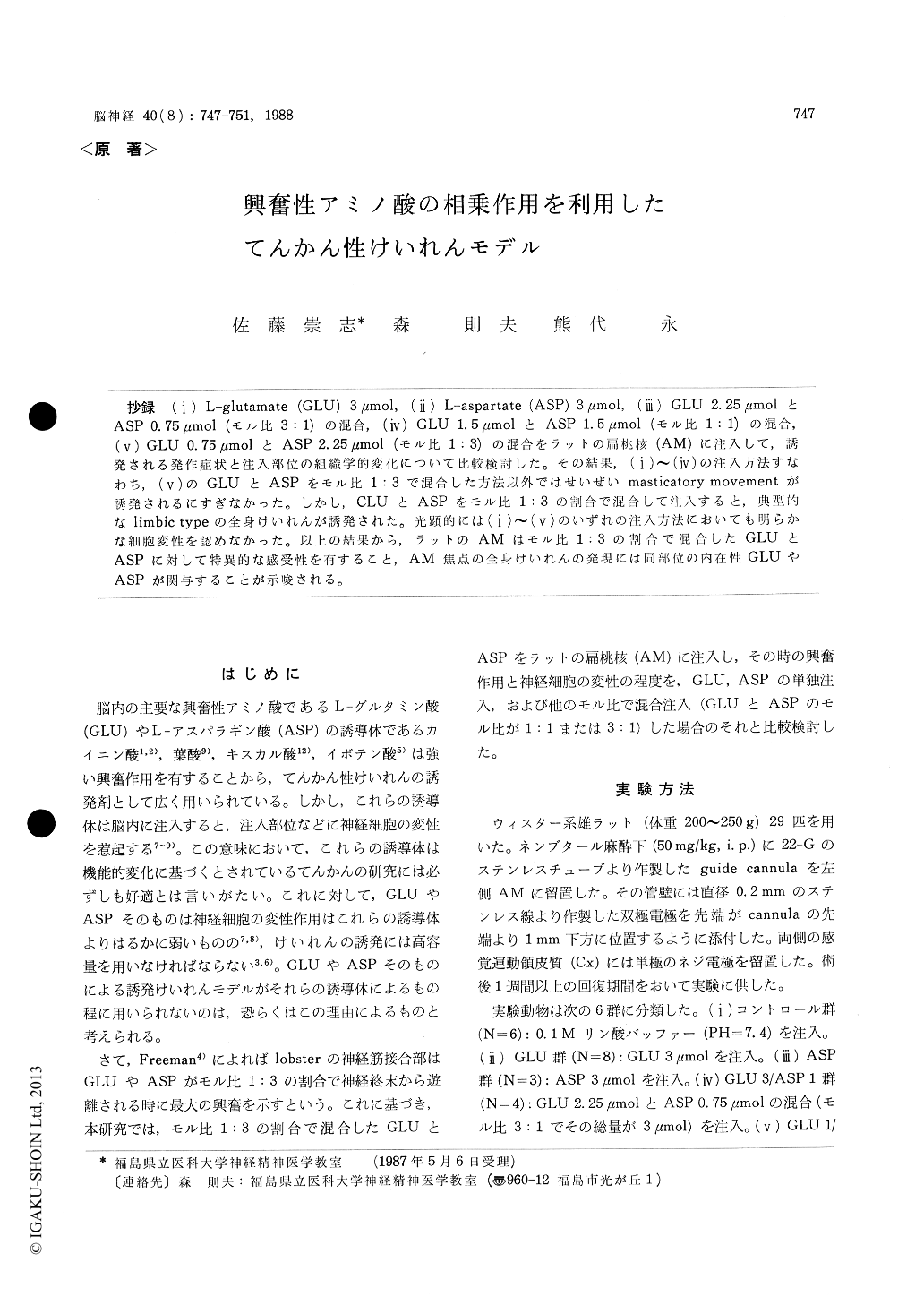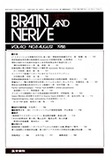Japanese
English
- 有料閲覧
- Abstract 文献概要
- 1ページ目 Look Inside
抄録 (i) L-glutamate (GLU)3μmol,(ii) L-aspartate (ASP)3μmol,(iii) GLU 2.25μmolとASP 0.75μmol (モル比3:1)の混合,(短) GLU 1.5μmolとASP 1.5μmol (モル比1:1)の混合,(v) GLU 0.75μmolとASP 2.25μmol (モル比1:3)の混合をラットの扁桃核(AM)に注入して,誘発される発作症状と注入部位の組織学的変化について比較検討した。その結果,(i)〜(iv)の注入方法すなわち,(v)のGLUとASPをモル比1:3で混合した方法以外ではせいぜいmasticatory movementが誘発されるにすぎなかった。しかし,CLUとASPをモル比1:3の割合で混合して注入すると,典型的なlimbic typeの全身けいれんが誘発された。光顕的には(i)〜(v)のいずれの注入方法においても明らかな細胞変性を認めなかった。以上の結果から,ラットのAMはモル比1:3の割合で混合したGLUとASPに対して特異的な感受性を有すること,AM焦点の全身けいれんの発現には同部位の内在性GLUやASPが関与することが示唆される。
L-glutamate (GLU) and L-aspartate (ASP), major excitatory amino acids in the brain, are believed to have an important role in the generalization and expression of epileptic seizures. Their ana-logues such as kainate, folate, ibotenate and quisqualate have been widely used to produce epileptic seizures, since they have a potent excita-tory action. However, these analogues produce striking neuronal damage at the injection site when injected intracerebrally. Therefore, these analogues are not appropriate for studying the mechanisms of epilepsy, which is believed to be based on the functional changes of the brain. On the other hand, although GLU and ASP themselves have minimal neurotoxic action, a relatively higher dosage than that of their analogues is needed to produce epileptic seizures. A recent report, in which Freeman has found that combined GLU/ASP released from the lobster neuromuscular synapse in a molar ratio of 1 : 3 (GLU/ASP) produces strong excitation, may provide some clue to this problem. In this study, we examined the features of epileptic seizures and neuronal damage follow-ing the injection of GLU/ASP combined in this molar ratio into the amygdala (AM) of rats.
Twenty-nine adult male Wistar rats weighing 200-250 g were used. All animals had received a cannula made of a 22-G stainless steel tube into the left AM. A bipolar recording electrode made of stainless steel wire was attached to its wall. The animals were divided into six groups accord-ing to the administration : Control group (N=6; injection of 0.1 M phosphate buffer), GLU group (N=8 ; injection of 3 μmoles of GLU), ASP group (N=3 ; injection of 3 μmoles of ASP), GLU 3/ASP 1 group (N= 4 ; injection ,of a combination of 2.25μmoles of GLU and 0.75 moles of ASP, molar ratio 3 : 1), GLU 1/ASP 1 group (N=3 ; injection of a combination of 1.5 μmoles of GLU and 1.5 μmoles of ASP, molar ratio 1 : 1), GLU 1/ASP 3 group (N=4 ; injection of a combination of 0.75 μmoles of GLU and 2.25 μmoles of ASP, molar ratio 1: 3). The amino acids were dissolved in a 0.1 M phosphate buffer and the volume for administration was always 1.0 μl. Two weeks after the administ-ration, the animals were perfused with 3% form-aldehyde, 3% glutaraldehyde, 0.2% picric acid and 0.1 M phosphate buffer under deep anesthesia. Frontal sections were stained with cresyl violet.
None of the control animals showed EEG or behavioral change. All the animals in the GLU group exhibited sporadic spikes but behavioral change. One of the three in the ASP group showed sporadic spikes but behavioral change ; however, the remaining two exhibited mastication. All the animals in both the GLU 3/ASP 1 and GLU 1/ASP 1 groups showed mastication. In contrast, all the animals in the GLU 1/ASP 3 group re-sponded with secondarily generalized convulsive seizure, i. e., rearing and/or falling. Light-micro-scopic examination displayed no detectable neu-ronal damage at the injection site.
This study shows that intra-AM injection of the combined GLU/ASP in a molar ratio of 1 : 3 (GLU /ASP) produces strong excitation without specific neuronal damage at the injection site. According-ly, the use of GLU/ASP combined in this molar ratio is conceived to be advantageous for study-ing the biophysiological mechanisms of epileptic seizures. The results of this study also suggest that endogenous GLU and ASP may be involved in the generalization and expression of generalized convulsive seizures of AM origin.

Copyright © 1988, Igaku-Shoin Ltd. All rights reserved.


